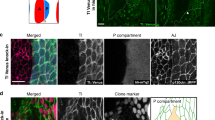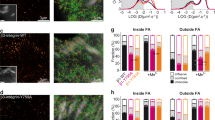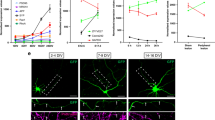Abstract
A MOLECULAR mechanism for selective axonal adhesion is a central question of neural development. Cell adhesion molecules have been identified1, but it has been difficult to ascribe functions for these proteins in vivo. Here we show that the neuronal membrane glycoprotein fasciclin I has a role in the adhesion of sister axons during the development of the grasshopper limb bud. To do this we used a new technique, chromophore-assisted laser inactivation (CALI), which causes the precisely timed thermal denaturation of specific proteins by laser light targeted through a dye-labelled antibody, without any other observable damage to living cells2. This can be achieved by relaxation of the laser-excited dye which releases heat to denature the bound protein; the rapid dissipation of heat with distance insulates unbound proteins from damage. CALI is a molecular analogue of cellular laser ablation and provides an unprecedented level of spatial and temporal resolution. Using dye-labelled antibodies that recognize fasciclin I, CALI disrupts fasciculation of the pioneer neurons without affecting their growth or guidance.
This is a preview of subscription content, access via your institution
Access options
Subscribe to this journal
Receive 51 print issues and online access
$199.00 per year
only $3.90 per issue
Buy this article
- Purchase on Springer Link
- Instant access to full article PDF
Prices may be subject to local taxes which are calculated during checkout
Similar content being viewed by others
References
Jessell, T. M. Neuron 1, 3–13 (1988).
Jay, D. G. Proc. natn. Acad. Sci. U.S.A. 85, 5454–5458 (1988).
Bastiani, M. J., Harrelson, A. L., Snow, P. M. & Goodman, C. S. Cell 48, 745–755 (1987).
Patel, N. H., Snow, P. M. & Goodman, C. S. Cell 48, 975–988 (1988).
Zinn, K., McAllister, L. & Goodman, C. S. Cell 53, 577–587 (1988).
Elkins, T., Hortsch, M., Bieber, A., Snow, P. & Goodman, C. S. J. Cell Biol. 110, 1825–1832 (1990).
Bate, C. M. Nature 260, 54–55 (1976).
Keshishian, H. & Bentley, D. Devl Biol. 96, 89–102 (1983).
Condic, M. L. and Bentley, D. J. Neurosci. 9, 2678–2686 (1989).
Jan, L. Y. & Jan, Y. N. Proc. natn. Acad. Sci. U.S.A. 79, 2700–2704 (1982).
Snow, P. M., Patel, N. H., Harrelson, A. L. & Goodman, C. S. J. Neurosci. 7, 4137–4144 (1987).
Caudy, M. & Bentley, D. J. Neurosci. 6, 1781–1795 (1986).
Keshishian H. & Bentley, D. Devl Biol. 96, 103–115 (1983).
Elkins, T. et al. Cell 60, 565–575 (1990).
Petrey, D., Buster, D., Donato, K. K. & Anderson, H. Devl Growth Differ. 31, 299–305 (1989).
Katz, F., Moats, W. & Jan, Y. N. EMBO J. 7, 3471–3477 (1988).
Johansen, J., Halpern, M. E. & Keshishian, H. J. Neurosci. 9, 4318–4332 (1989).
Author information
Authors and Affiliations
Rights and permissions
About this article
Cite this article
Jay, D., Keshishian, H. Laser inactivation of fasciclin I disrupts axon adhesion of grasshopper pioneer neurons. Nature 348, 548–550 (1990). https://doi.org/10.1038/348548a0
Received:
Accepted:
Issue Date:
DOI: https://doi.org/10.1038/348548a0
This article is cited by
-
Transient photothermal inactivation of Escherichia coli stained with visible dyes by using a nanosecond pulsed laser
Scientific Reports (2020)
-
A locust embryo as predictive developmental neurotoxicity testing system for pioneer axon pathway formation
Archives of Toxicology (2020)
-
Illuminating developmental biology through photochemistry
Nature Chemical Biology (2017)
-
Chromophore-assisted laser inactivation in neural development
Neuroscience Bulletin (2012)
-
Asymmetric retraction of growth cone filopodia following focal inactivation of calcineurin
Nature (1995)
Comments
By submitting a comment you agree to abide by our Terms and Community Guidelines. If you find something abusive or that does not comply with our terms or guidelines please flag it as inappropriate.



